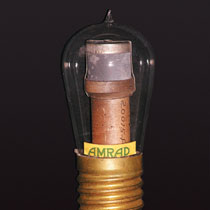|
|
afterimage
Before YouTube: S-Tube
When I was a student in the sixties, I discovered that Tufts’ Halligan
Hall began life as the manufacturing plant of the American Radio and Research
Corporation. AMRAD, as it was known, made radio components and operated
one of the country’s first commercial radio stations, 1XE, later
WGI, which started broadcasting in 1916 with a 300-foot antenna on top
of the Hill and featured talks by Tufts faculty.
Perhaps the most noteworthy innovation to come out of AMRAD was the S-tube. Designed by a distinguished trio—the former Tufts roommates Vannevar Bush, A11 (future presidential science adviser), and Laurence K. Marshall, A11 (future chair of Raytheon), along with the Harvard physicist Charles G. Smith—the tube dramatically improved the way radio transmitters converted alternating current to direct current. By 1926, AMRAD was bankrupt, but the S-tube would live on. Bush, Marshall, and Smith purchased the relevant patents, and brought them to their new company, Raytheon, which produced different versions of the device into the forties. Over the years, I have collected information on AMRAD and even found an original S-tube, manufactured in Halligan Hall. It’s the one shown above.
—Thomas M. Hart, A68, A05P
|
|


